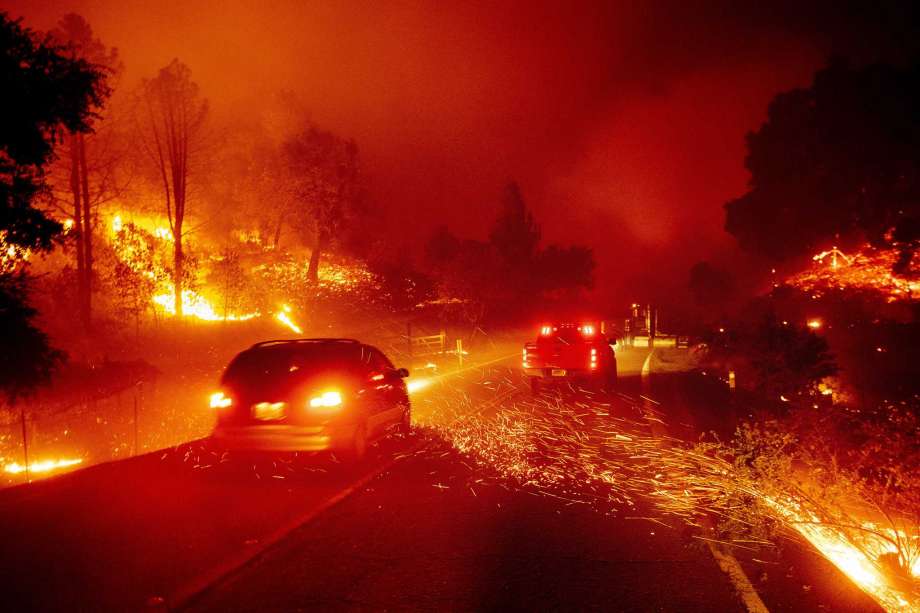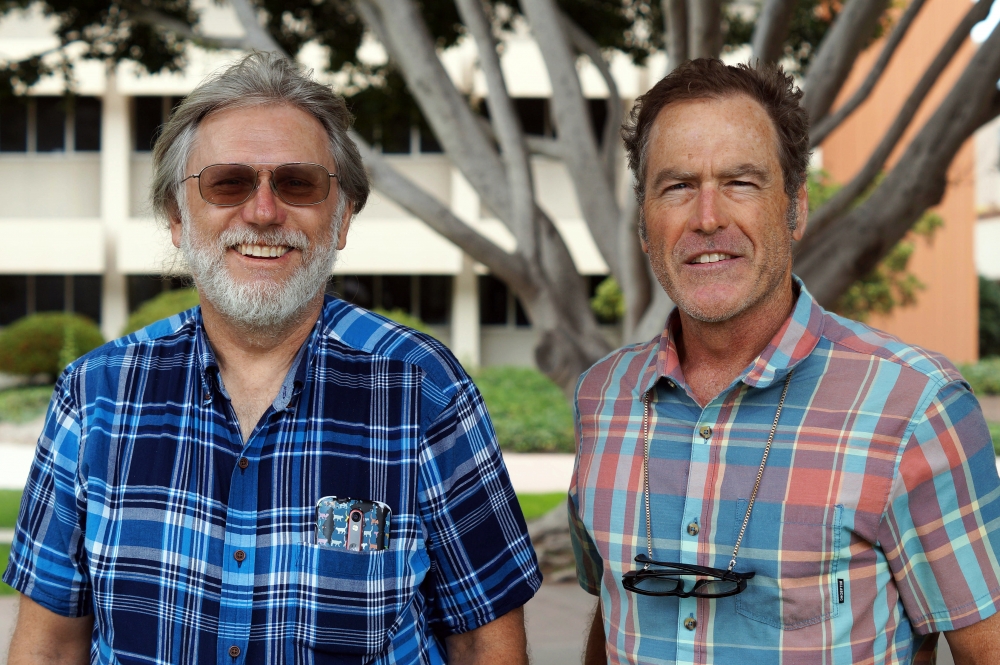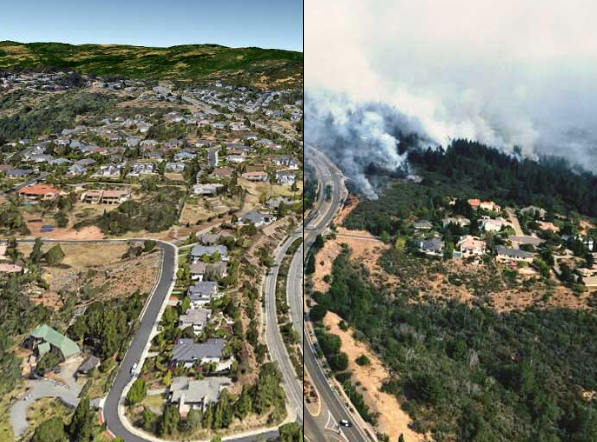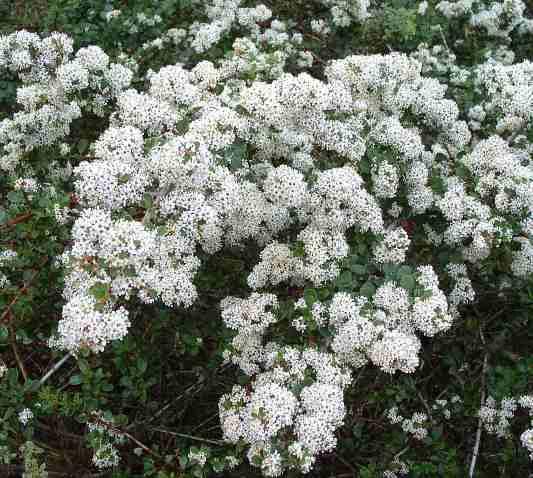
Shifting Winds in Fire Management

Right now, firefighters are battling massive and as yet out-of-control blazes in Los Angeles, San Bernardino and Sonoma counties.
The American West is getting hotter and drier, and that has driven a quick succession of ever more devastating wildfires. Clearly, we need to examine our approach to fire risk management.
It’s a complicated matter made more so, researchers say, because politicians and the public tend to conflate two rather different problems. “We are mixing up the problem of forest and fuel management with the problem of wildland-urban interface fires,” explained Max Moritz, an adjunct professor at UC Santa Barbara’s Bren School of Environmental Management and a statewide Cooperative Extension wildfire specialist.
Fire management often focuses on controlling the extent and distribution of fuels, explained Geography Professor Dar Roberts, who serves as UC Santa Barbara’s principal investigator of the Southern California Wildfire Hazard Center. For instance, he said, fire agencies create fire breaks, or bare strips between flammable areas, to provide a stopgap to a fire’s progress. These breaks also often serve as roads for firefighters to mobilize resources.
In another tried and true strategy for forests, firefighters will conduct prescribed burns to reduce the fuel load in an area. This prevents debris from accumulating to a point where it could fuel a conflagration.
Unfortunately, the techniques used out in the forests don’t apply when it comes to fires burning through neighborhoods and homes. The problems are not even closely related, but academics have had a difficult time communicating this to the public. “It’s a huge part of why we’re actually not making much progress toward solving that wildland-urban interface problem,” said Moritz, “because that’s a problem of where and how we’ve built our communities.”
Changing our communities
California sets building codes in an attempt to ensure that structures are safe, sturdy and resilient against human and natural accidents. However, the state does not have similar codes at the community scale. And according to Moritz, most of the solutions to wildland-urban interface fires lie in city planning. “You can lay out a community in a way that’s much safer: buffered, easier to evacuate, easier to defend. And that’s urban planning and design,” he said.
For instance, developers often build houses along a perimeter road with backyards adjacent to the surrounding flammable landscape. Planners could designate this land for irrigated parks or community gardens, which would provide a buffer zone between the community and the wildlands. The road would then serve as a firebreak, further insulating the neighborhood from a wildfire roaring through the area.
“All those ideas are in people’s heads but they’re not codified into a consistent set of best practices or land use and urban planning guidelines that apply from county to county and city to city,” said Moritz.
The California Department of Forestry and Fire Protection, also known as CalFire, does provide some higher-level suggestions, but they are mostly limited to road considerations, water supplies and fuel recommendations. “So there is some ‘community-scale’ fire guidance out there,” said Moritz, “but it's not very comprehensive and still only a recommendation.” The state also issues fire hazard severity zone maps that provide consistent methodology for the whole state, but how those are utilized at the local level varies, Moritz said.
City planners and firefighters also have to contend with buildings and communities already in place when addressing the wildland-urban interface challenge. In these places, solutions must involve optimizing what is already there.

This neighborhood in northern Santa Rosa caught fire in October of 2017. The layout of the community is a good illustration of the wildland-urban interface problem.
Photo Credit: GOOGLE EARTH AND CALIFORNIA HIGHWAY PATROL
There are many ways to retrofit an existing structure to harden it against wildfire. Some are intuitive. Maintaining a brush and debris-free perimeter around a house, for example, drastically lowers the chance of the structure igniting, while also providing an area that fire fighters can defend. Tile roofs also increase a structure’s fire resistance, especially if the gaps between them are covered to prevent embers from blowing in underneath.
Other improvements are less apparent. “Another really easy way to better defend a house is double-paned glass,” said Roberts. Glass is fairly opaque to thermal radiation, so a double-pane window provides twice as much shielding. What’s more, the air between the two panes provides additional insulation. “Given sufficient time, that window will melt,” said Roberts, “but fires often go through pretty fast, and so it doesn’t take that much to prevent the house from blowing up from the inside.”
Sometimes, the best course of action is to leave things the way they are. For instance, orchards are different from natural vegetation because they’re irrigated and green. “In Santa Barbara, the best thing we could do is preserve our orchards,” said Roberts, “because in any place we have an orchard it actually acts as a defensible barrier against fire spread.”
Staying safe
When it comes to evacuation plans, the primary strategy in the U.S. is to get out. Unfortunately, with these large, fast-moving fires, some people aren’t leaving in time — or don’t have enough time to escape.
“That’s a big part of what we saw up north this year,” said Moritz. “Lots of people leaving too late and either dying in their cars or having to get out of their cars and run.”
Both Roberts and Moritz hope that California will continue to provide earlier evacuation warnings to people in the fire’s path. The researchers also agree that we should consider additional strategies for protecting ourselves, such as the use of local fire shelters (much like tornado shelters), which could protect individuals who find themselves outpaced by the flames.
The practice of sheltering in place is so common in Australia that the country has an associated saying: “Prepare, Stay and Defend, or Leave Early.” In essence, property owners decide whether to flee the flames or hunker down and protect their land, and many of them are prepared for just such a situation, said Moritz. This strategy has now begun to emerge in the U.S. For instance, Pepperdine University, in Malibu, told students to shelter in place during the November 2018 Woolsey fire, since the school’s concrete buildings and well-watered lawns were unlikely to burn.
“The question is do we want to advocate shelter-in-place?” said Moritz. “Most firefighters do not because it’s a lot of liability for them. They want to get this message really clear, ‘when we tell you to go, you go.’ And there’s no gray area here.”
“But there is a gray area,” he said, “because what if people don’t get the message in time?” We don’t have an education campaign or a plan for this unfortunate and quite deadly possibility, he added.
Australia has also taken a more nuanced approach to fire warnings since the Black Saturday bushfires of 2009, which claimed 173 lives, according to official findings. The country has since revamped its evacuation protocols. “Now there doesn’t even have to be a fire for them to trigger an evacuation,” said Moritz — the potential danger of a particularly hot, dry, windy day can prompt an evacuation order. California may do well adopting a similarly cautious approach, Roberts and Moritz suggested.
You can manage only so much
Out in the wild, management works only up to a point: until shifting conditions change the game. “Fires are behaving in ways that many of these agencies have not experienced before,” said Roberts. “Under extreme weather conditions the best management in the forests is probably not going to be good enough.”
Different ecosystems have different fire regimes. Yellowstone’s lodgepole pine forests have adapted to immense conflagrations that strip the landscape once every few centuries. Much of the California chaparral, on the other hand, has evolved to cope with fires sweeping through every 30 to 60 years. “The natural fire regime of all these systems actually varies quite a bit,” Moritz explained, “but the key is that we want fire in those systems doing the right kind of work that they’re adapted to.”

Bigpod ceanothus requires fire to complete its lifecycle.
Photo Credit: LAS PILITAS NURSERY
California’s forests and chaparral are adapted to periodic fires. Many plants even require fire at some point in their lifecycles. Take the bigpod ceanothus, a shrub endemic to California’s central coast and Channel Islands. It needs fire for its seeds to germinate, otherwise they lie dormant in the soil. However, smaller, more frequent fires can kill new shoots and sprouts before they can prepare themselves for the next fire.
What’s more, large fires can occur in surprisingly rapid succession under severe weather or drought conditions. “Under extreme conditions it only takes maybe two or three years of recovery before a fire can easily spread through an older scar,” said Roberts. This leaves the landscape vulnerable to invasive grasses, which can go up in flame on a yearly cycle.
“It’s a positive feedback loop,” added Moritz. “You have more and more fire in the landscape, which is knocking out more and more native chaparral, which bringing more grasses and fire to the landscape.”
Some fires are driven by accumulated fuel. For these, a thick layer of dry underbrush from decades of fire suppression can lead to an inferno. “However there’s a tradeoff between the weather conditions and the fuel,” said Moritz. “When the weather conditions are bad, the fuel doesn’t matter as much, and when the conditions are mild, the fuel characteristics matter a lot more.”
“Under extreme conditions, fires just burn everything in their paths,” added Roberts. And as the climate shifts, the Western U.S. has experienced more frequent, more severe weather conditions. Higher average temperatures, prolonged droughts and lower humidity all contribute to the region’s growing fire problem. In California, these conditions are often exacerbated by intense, dry winds that bear down upon the coasts from the state’s interior.
“Given that there’s going to be big fires, and there’s likely going to be no way to prevent them from happening, what we need to do is figure out ways to minimize damage,” said Roberts. “We have to adapt.”
“For us it’s fires, but for other places it’s floods, and other places it’s hurricanes, and then other places it’s sea level rise,” he added. “There’s all these things that we’re going to have to be pretty adept on our feet and adapt to.”



